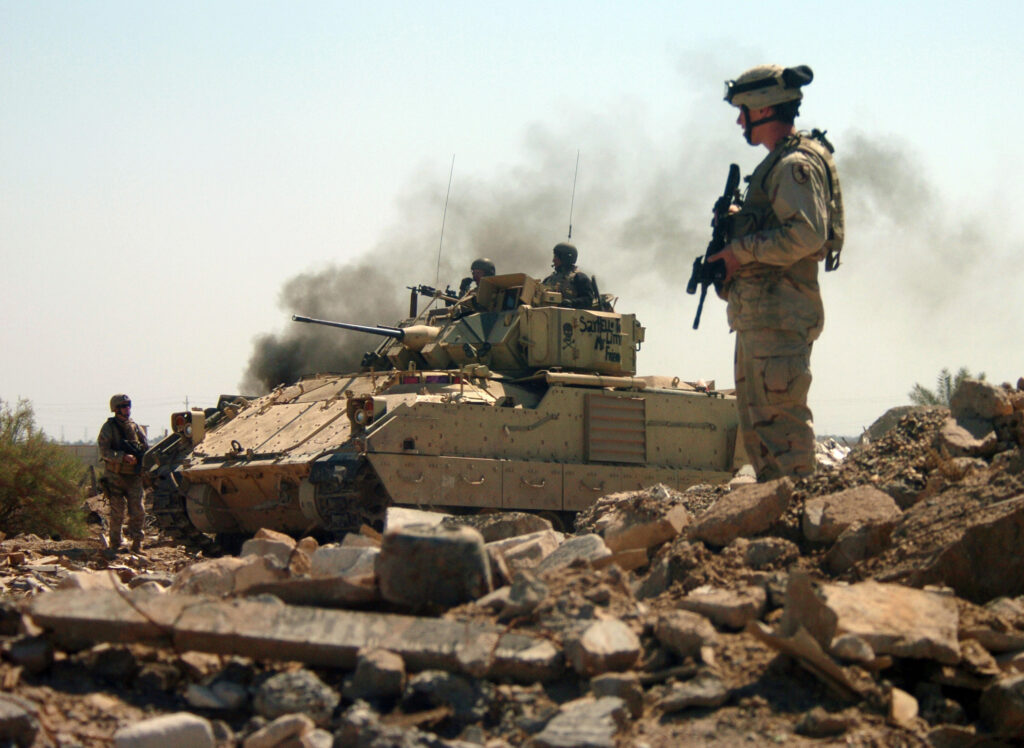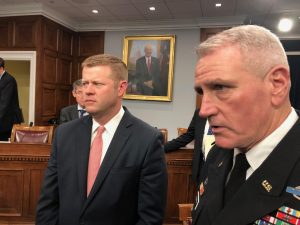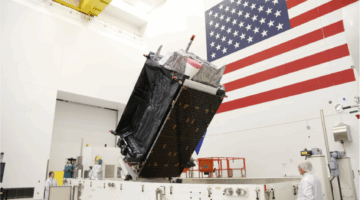
PENTAGON: At 12:01 today, three weeks and a day after the Optionally Manned Fighting Vehicle program derailed in its rush to replace the Reagan-era M2 Bradley by 2026, the Army launched a new lower-pressure, lower-cost approach to OMFV, one it hopes will embolden more companies to compete. But with three cancelled Bradley replacement efforts in the last 11 years, will thrice-burned defense contractors give the Army another chance?

“You’re absolutely right, trust is a big part of this,” said the four-star chief of Army Futures Command, Gen. John “Mike” Murray, when I raised the issue on a press call this morning. “We can assure everybody that the Army is absolutely committed to the development of this vehicle, and we haven’t walked away from that.”
“We are approaching this significantly differently,” said Assistant Secretary Bruce Jette, the Army’s civilian senior acquisition executive (SAE). For one thing, he said, “in the prior approach, there was a much deeper dependency on the industry’s cost sharing.”
To put it plainly, the Army had required each competitor to build a full-up working prototype at its own expense. Only two competitors tried, and the Army effectively disqualified both of them: a Raytheon-Rheinmetall team for not delivering their vehicle on time; a General Dynamics team for not meeting performance requirements, requirements which, Murray and Jette have admitted, may have been too ambitious for any company to meet on the Army’s tight timeline.

This time around, with a OMFV Market Survey posted online at 12:01 pm today, the Army is asking the companies what they think the requirements and the timeline should be. In fact, the only deadline in the new approach is the one for companies to respond to the Market Survey: three weeks from now, at 5 pm on Feb 28.
The Page & A Half Solution
Today’s survey starts with the Army asking industry, in effect, where did we go wrong?
“Part 1: Cancelled Solicitation Feedback…. [Question] 1. What did your company consider when making a bid/no-bid decision for the OMFV….2. What items will impact your participation in follow-on OMFV Competition(s)?….3 Please provide recommendations for revisions….”
The rest of the document – the humblest government solicitation I’ve ever seen – asks for recommendations on 15 different items, from “technical requirements” to “competition [:] when and where in the overall approach?” to “future Industry Engagements – types and timing.”
Instead of issuing formal, detailed requirements, even in a draft form subject to change, the Army will provide industry a “characteristics document,” a broad-strokes list of desires that leaves industry lots of leeway to offer different solutions.
“It’s a page-and-a-half to include the signature block,” said Murray. While the characteristics document isn’t yet finalized – he promised to release it as soon as it was – he did sum up the Army’s nine desires for OMFV:
- “It’s got to protect soldiers.”
- “It’s got to keep pace in a combined arms formation.”
- “We’ve got to be able to upgrade this over time, so it’s got to be capable of growth without significantly increasing the weight.”
- “It’s got to be lethal if it’s going to survive on the modern battlefield.”
- “It’s got to traverse bridges and get across most of the MSRs, [the] Main Supply Routes [in regions] that we’re talking about being in.”
- “We’ve got to be able to transport it by rail, by air, by sea.”
- “We’ve got to be able to put [troops] in the back of it” — since the fundamental purpose of the Bradley, which OMFV must replace, is to carry combat infantry through hostile fire.
- “We would like it …to take advantage of [the in-development] Synthetic Training Environment, so on-board training systems would be preferable.”
- “We would like it to reduce the logistics burden on future commanders, so we’re looking for different ideas in terms of energy efficiency.”
In contrast to the cancelled competition, which imposed strict requirements for air transportability, “nowhere on this document does it say ‘two per C-17’ or less than a certain weight,’” Murray said.
What’s more, he emphasized, “Time is not on here. Time will be determined based on what we’re asking for in terms of the characteristics and what industry is capable of delivering.
“i have been told for four years,” Murray said, “by industry leaders, CEOs primarily, ‘just describe the problem for us and let us be innovative in our solutions’ – and that’s what we’re trying to do.”
Five Phases, Zero Deadlines
So what comes after the Army receives industry’s responses to the market survey on Feb. 28th? This time, instead of jumping immediately to writing detailed requirements for physical prototypes, there is a multi-part competition with five phases – none of which, Jette and Murray emphasized, currently has a specific date:
- White paper proposals: Based on the written responses to the market survey, ongoing discussions with industry, and its own post-mortem of the first attempt at OMFV, the Army will refine its nine characteristics and request industry to submit white papers on how to achieve them – and how long it might take.
- Preliminary digital design: After evaluating the white papers, Jette said, the Army will award five contracts for industry teams to produce “a rough digital prototype” of their OMFV proposal. Instead of “bending metal” to build a physical prototype, he explained, the competitors will produce the same kind of digital model that automakers commonly use to work out their designs. These models will be assessed not just by Army leaders and technocrats, Murray added, but by rank-and-file soldiers who have hands-on experience operating armored vehicles.
- Detailed detail design: Of the five preliminary digital designs, the Army will then select three, four, or even all five to refine their ideas into a “detailed digital design,” Jette said. (This is the model used by the Future Attack Reconnaissance Aircraft program). These designs will receive more rounds of soldier feedback and ultimately pass through something analogous to the Critical Design Review (CDR) phase of a traditional program, where the competitors must prove their proposed technologies will not only work, but work together in an integrated system on the battlefield.
- Competitive prototype production: The Army will pick the two most promising detailed designs to actually build physical prototypes for real-world testing, with all the usual field trials required by Pentagon acquisition regulations and federal procurement law. That’s the same step the Army tried to jump to last fall with its first attempt at OMFV.
- Production: Finally, the Army will select one vendor to mass-produce actual combat vehicles, built to formal, detailed requirements. While the previous steps will be conducted under streamlined acquisition procedures – using both Middle-Tier Acquisition (aka Section 804) and Other Transaction Authority (OTA) – the production phase may transition to a formal, full-up program of record under the Defense Federal Acquisition Regulations (DFAR), Jette said. But, he added, it might be possible to start production under the Section 804 rules. (Presumably, this would only apply to what’s called Low-Rate Initial Production, since full-rate production of hundreds of combat vehicles is by definition no longer “midlde-tier”).
“Notice I didn’t tell you how long it’s going to take to get to any particular phase,” Jette said. “A vendor …may come in and say, ‘I can do this in three years, four years, five years, six years, seven years.’ Then Gen. Murray and the uniformed side of things will look at the capabilities that can be brought to the field by a particular point in time, make a determination as to the need for a vehicle by a particular time as well, combine those two, and we’ll determine the right point … to move into the production phase.”

In other words: Instead of the Army imposing a timeline, competitors will be able to propose a timeline, which is one of the factors they’ll be judged on, along with capability and cost. And the Army will assess the tradeoff between time and technology – whether to take longer to develop more tech, or accept less to move faster – in the strategic context of how urgently frontline units need the new vehicle.

All this means the original 2026 date to field the First Unit Equipped (FUE) with OMFV is no longer the Army’s deadline. Both the Secretary of the Army, Ryan McCarthy, and the Chief of Staff, Gen. James McConville, have approved this approach, Jette said: “They believe that the objective is to get the right vehicle for the soldier [and] they’re open to us redefining the FUE date.”
Just as important, industry leaders are open to the new approach, Jette insisted: “I’ve spoken to a large number of the companies that have either in the past expressed an interest in being OEMs, or that we think ought to consider being OEMs, at the senior executive level, CEOs and presidents of corporations.”
“This is a much better path forward… much more cost effective and flexibles… where the barrier to entry is much lower for their investment going forward,” Jette said. “By going to a digital design — which most of them do anyway — it makes it much easier for a company to participate as an OEM [Original Equipment Manufacturer] than if I was to start off by asking them to deliver a [physical] vehicle.”
But how much of their own money will companies have to risk this time? While industry is free to develop new technology at their own expense, Jette said, “generally we’ll be funding the development of the vehicle.”

